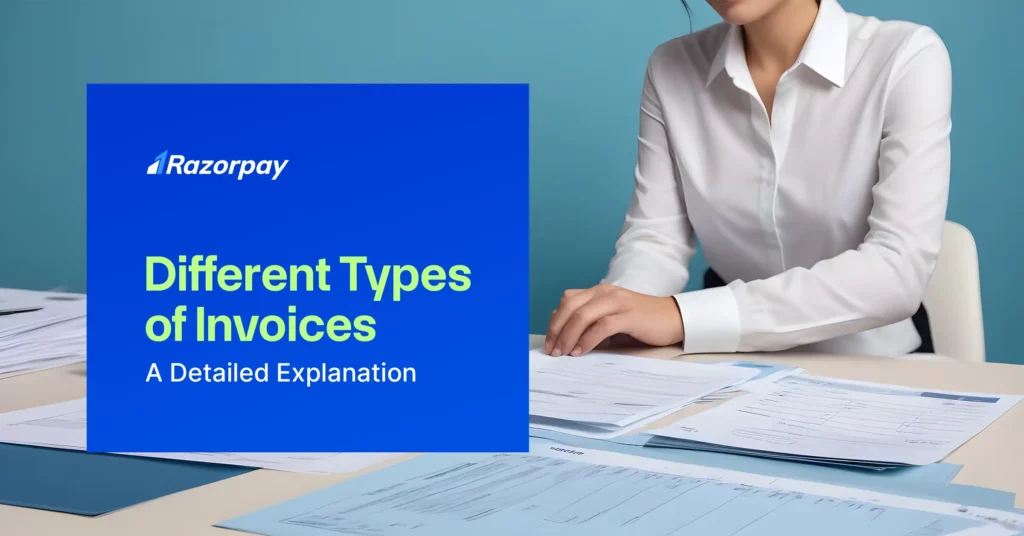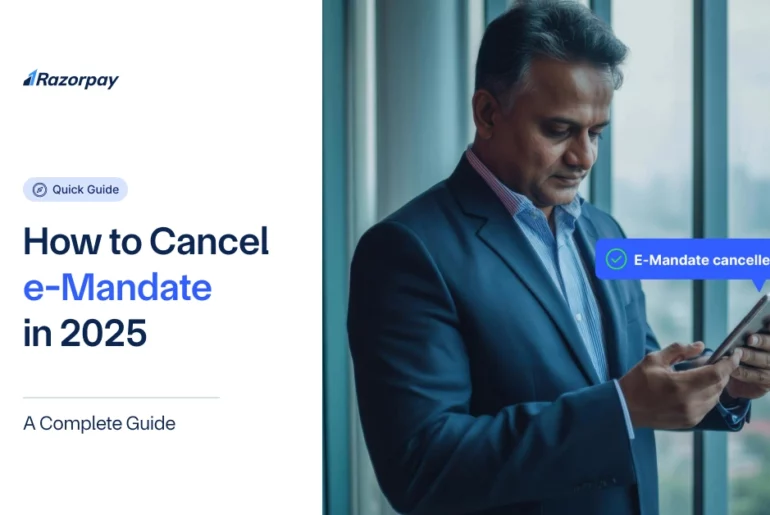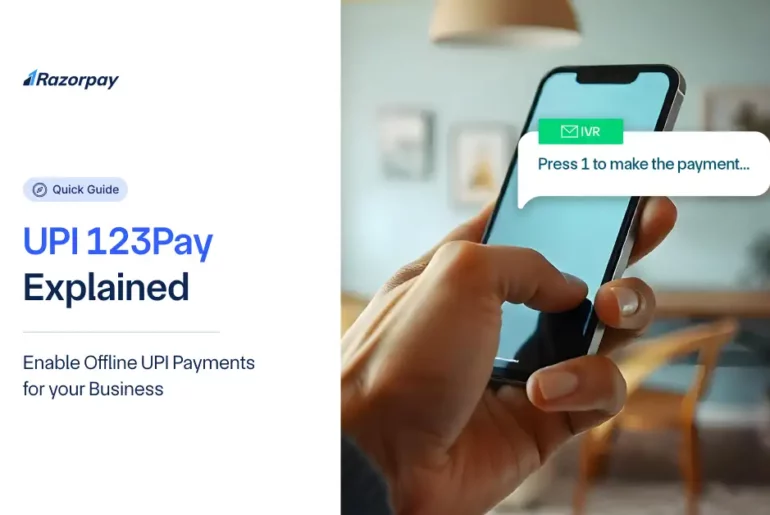Effective invoice management is crucial for maintaining healthy cash flow. By ensuring timely payments through clear terms and conditions, businesses can accurately track income and establish a clear transaction record.
In this article, we explore 15 different types of invoices that every business should be familiar with, covering various purposes from standard transactions to specialized billing needs across different industries.
Related Read: What is an Invoice?
Table of Contents
Different Types of Invoices
Invoices are essential business documents that summarize transaction details, request payment, and serve as legal records. A typical invoice includes product or service descriptions, quantities, prices, customer information, and payment initiation options.
By understanding the various invoice types, businesses can effectively manage cash flow and maintain accurate financial records.
Related Read: Quote vs Invoice: Key Differences Explained
1. Standard Invoices (One-Time Transactions)
1.1 Proforma Invoice (Quote/Estimate)
A proforma invoice is a preliminary, non-binding estimate issued before a sale is confirmed. It outlines projected costs, terms, and conditions, providing a basis for negotiation. It’s essential for budgeting and planning purposes for both buyer and seller.
Example of Proforma Invoice
A furniture manufacturer might send a proforma invoice to a hotel chain for a bulk order of custom-made chairs. This allows the hotel to budget accurately for the refurbishment project.
Key elements of a proforma invoice include:
- Itemized costs
- Delivery dates
- Payment terms
- Buyer and seller details
1.2 Sales Invoice (“Regular” Invoice)
A sales invoice is an accounting document issued by a seller to a customer detailing the goods or services provided and the corresponding costs. It serves as a legal request for payment, outlining transaction details, payment terms, and the total amount due.
Example of Sales Invoice
A marketing agency sends a sales invoice to a client after completing a branding project. The client can then process the payment according to their internal procedures.
Key elements of a sales invoice include:
- Seller and buyer information
- Itemized charges
- Payment terms
1.3 Overdue Invoice
An overdue invoice arises when a customer fails to pay within the specified timeframe. It’s a formal notification reminding the customer of the outstanding balance and initiates the collections process.
Example of Overdue Invoice
A wholesaler might send an overdue invoice to a retailer who hasn’t paid for goods 30 days after the initial due date. This often prompts the retailer to prioritise the payment or reach out to discuss any issues.
Key elements of an overdue invoice include:
- Late fees (if applicable)
- Updated payment terms
- Contact information
Related Read : What is Overdue Payment?
1.4 Consolidated Invoice
Consolidated invoice simplifies payments by combining multiple subscriptions into a single bill, improving efficiency and customer experience.
Example of Consolidated Invoice
A large corporation might receive a consolidated invoice from its office supplies vendor, covering all purchases made during the previous month. This streamlines the payment process and reduces the number of individual transactions.
Key elements of a consolidated invoice include:
- Individual invoice numbers and dates
- Total amount due
- Invoices for Projects
2. Invoices for Projects
2.1 Retainer Invoice
A retainer invoice is a pre-payment for ongoing services, ensuring a steady income stream for the service provider. It demonstrates client commitment to the project and provides financial stability for the business.
Example of Retainer Invoice
A marketing agency might issue a retainer invoice to a client for 20 hours of consulting work per month. This ensures the agency has dedicated resources available and a guaranteed income stream.
Key elements of a retainer invoice include:
- Retainer amount
- Services covered
- Time period
- Terms and conditions
2.2 Interim Invoices
Interim invoices are partial bills issued during a project, ensuring steady cash flow for the service provider while the project progresses.They help fund ongoing work and cover expenses as the project unfolds.
Example of Interim Invoices
A web development company might send interim invoices after completing specific project milestones, such as wire-framing, design, and initial coding phases. This approach helps maintain project momentum and client engagement.
Key elements of a interim invoices include:
- Progress percentages
- Completed milestones
- Corresponding charges
2.3 Timesheet Invoice
A timesheet invoice bills clients based on hours worked. It’s particularly useful in service industries where work hours can vary significantly from project to project.
Example of Timesheet Invoice
A legal consultant might submit a timesheet invoice detailing hours spent on research, client meetings, and document preparation for a specific case.This transparency helps build trust with the client.
Key elements of a timesheet invoice include:
- Hourly rates
- Total hours worked
- Detailed breakdown of tasks
2.4 Final Invoice
A final invoice is issued at the project’s completion to request payment for any remaining balances. It summarizes total project costs and finalizes the transaction.
Example of Final Invoice
A construction company sending a final invoice after completing a building renovation. This marks the successful conclusion of the project and the fulfillment of contractual obligations.
Key elements of a final invoice include:
- Total project costs
- Payments received to date
- Payment instructions
- Adjustment Invoices
3. Adjustment Invoices
3.1 Credit Invoice (Refund/Discount)
A credit note, or credit memo, is a document issued to rectify overcharges, returns, or discounts, reducing a customer’s outstanding balance. It details the amount credited and the reason for the adjustment.
Example of Credit Invoice
An electronics retailer might issue a credit invoice to a customer who returned a faulty laptop. This helps maintain good customer relations and complies with consumer protection laws.
Key elements of a credit invoice include:
- Credited amount
- Reason for credit
- Applicable charges
3.2 Debit Invoice (Additional Charges)
A debit note, or debit memo, is a document issued to increase a customer’s outstanding balance due to additional charges or corrections to a previous invoice. It provides transparency about the changes and ensures accurate accounting.
Example of Debit Invoice
A printing company might issue a debit invoice for rush fees when a client requests faster turnaround on an order. This ensures the company is fairly compensated for the additional resources required.
Key elements of a debit invoice include:
- Additional charges
- Reason for debit
- Revised invoice
3.3 Mixed Invoice
A mixed invoice consolidates credit and debit adjustments into a single document, providing a comprehensive overview of account changes. It simplifies reconciliation by presenting a net balance, which can be positive, negative, or zero. This invoice type is useful for managing multiple transactions or adjustments within a single billing cycle.
Example of Mixed Invoice
A software service provider issuing a mixed invoice that credits a client for downtime but also charges for additional user licenses added mid-month, ensuring transparent and detailed billing.
Key elements of a mixed invoice include:
- Credited amounts and reasons
- Debited amounts and reasons
- Revised total balance
- Special Purpose Invoices
4. Special Purpose Invoices
4.1 Commercial Invoice
A commercial invoice is a formal document required for international shipments, detailing exported goods, their value, quantity, and terms of sale. It assists customs authorities in calculating duties and taxes, facilitating smooth cross-border trade.
Example of Commercial Invoice
A UK-based manufacturer exporting machinery to the United States would issue a commercial invoice. This facilitates smooth customs clearance and helps avoid delays in international shipping.
Related Read: What Is a Shipping Invoice?
Key elements of a commercial invoice include:
- Shipment details
- Detailed product descriptions
- Quantities and values
4.2 Recurring Invoice
Recurring invoices are automated bills generated at regular intervals for consistent services or subscriptions, ensuring predictable revenue and streamlined billing for both businesses and customers.
Example of Recurring Invoice
A software-as-a-service (SaaS) company that sends monthly recurring invoices to subscribers for their chosen service plan. This model provides predictable revenue for the company and consistent service for the client.
Key elements of a recurring invoice include:
- Billing frequency
- Subscription details
- Automatic payment information
- Next billing date
4.3 Expense Report Invoice (Reimbursing Expenses)
Expense reports are formal documents submitted by employees or contractors to claim reimbursement for business-related expenses. They itemize expenditures, require supporting documentation like receipts, and undergo an approval process before payment.
Example of Expense Report Invoice
A sales representative might submit an expense report invoice for travel costs, meals, and accommodation after attending a trade show on behalf of their company. This ensures the employee is promptly reimbursed for out-of-pocket expenses.
Key elements of an expense report invoice include:
- Itemized list of expenses
- Dates of expenditure
- Receipts or proof of purchase
- Total reimbursement amount
4.4 Past Due Invoice (Payment Reminder)
A past-due invoice is a formal notification sent to customers who have failed to meet the original payment deadline. It reiterates invoice details and may include late fees or payment consequences..
Example of Past Due Invoice
An office supplies vendor might send a past due invoice to a client who hasn’t paid their bill 30 days after the due date. This often leads to a conversation about payment terms or any issues the client may be experiencing.
Key elements of a past due invoice include:
- Original invoice details
- Number of days overdue
- Late fees (if applicable)
- Updated payment instructions
Create your Invoices with Razorpay Invoicing Software
Types of Invoice Formats
In today’s digital age, there are two primary types of invoice formats:
Digital Invoices
Digital invoices are electronic documents created, sent, and processed digitally, streamlining invoicing and reducing paperwork. They offer efficiency, accuracy, and environmental benefits compared to paper invoices.
For example, a mid-sized marketing agency might use invoicing software to generate and email professional-looking invoices to clients. This digital approach allows the agency to create, send quickly, and track invoices for multiple clients and projects simultaneously, improving their cash flow management and reducing administrative overhead.
Key features of digital invoices include:
- Customizable templates
- Automated calculations
E-invoices
E-invoices, or electronic invoices, are structured digital documents exchanged directly between the buyer’s and seller’s accounting systems without manual intervention. They’re designed for seamless invoice processing and often helps to improve the overall efficiency.
For example, a large corporation implementing an e-invoicing system with its suppliers to automate accounts payable processes and comply with government regulations. This system aims to streamline operations, reduce errors, and improve overall financial efficiency.
Key elements of e-invoices include:
- Interoperability
- Automated invoice processing capabilities
- Compliance with e-invoicing regulations
Related Read: What is Invoice Reconciliation?
Conclusion
Understanding what are different types of invoices is crucial for effective financial management across various industries and business models. Before creating an invoice, it’s essential to identify its purpose. This ensures you select the most appropriate type, include all necessary information, and comply with relevant regulations.
By mastering the art of invoicing, you can streamline your billing processes, improve cash flow, and maintain clear financial records.
Related Read: Difference Between an Invoice and Receipt
FAQs
1. How can I choose the right type of invoice for my business needs?
Consider the nature of your transaction, payment terms, and industry standards. For one-time sales, a standard invoice suffices. For ongoing projects, consider interim or recurring invoices. For international transactions, use commercial invoices. Always align your choice with your business model and client relationships.
2. What information should be included in a standard sales invoice?
A standard sales invoice should include your company details, client information, a unique invoice number, issue date, payment due date, itemized list of goods or services, quantities, unit prices, total amount due, payment terms, and accepted payment methods. Including your tax identification number is also crucial for compliance.
3. When should a company issue a credit memo to a customer?
A company should issue a credit memo when refunding or reducing a customer’s balance. This typically occurs for returned goods, overpayments, billing errors, or as a goodwill gesture. Credit memos ensure accurate accounting records and help maintain positive customer relationships.
4. Can a debit memo be issued for services already provided?
Yes, a debit memo can be issued for services already provided if additional charges are necessary. This might occur if the scope of work expanded beyond the original agreement, if there were unforeseen expenses, or to correct an undercharge on the original invoice.
5. What is the difference between a final invoice and an interim invoice?
An interim invoice is issued during a project to bill for completed portions of work, helping with cash flow. A final invoice is sent at the project’s completion, summarizing all costs, including any changes or additions, and requesting payment of any remaining balance.
6. Are POS (Point of Sale) transactions considered invoices?
While POS receipts share similarities with invoices, they’re typically not considered formal invoices. However, for tax purposes, POS receipts often serve as simplified invoices for small transactions. For larger purchases or B2B transactions, a formal tax invoice is usually required in addition to the POS receipt.



